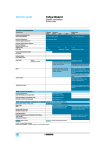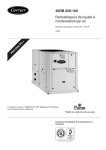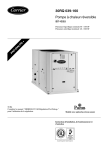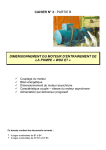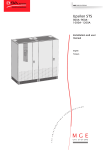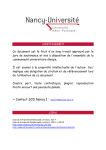Download MGE UPS Systems 30A Power Supply User Manual
Transcript
www.mgeups.com MGE UPS SYSTEMS Galaxy 3000 10 - 30 kVA Upsilon STS 30A-60A-100A-160A 250A-400A-600A Installation and user manual P P O W E D E R V I O R R LE SAVOIR FAIRE MERLIN GERIN T H E U N I N T E R R U P T I B L E 34020113EN/AA - Page 1 Page 2 - 34020113EN/AA Introduction Thank you for selecting an MGE UPS SYSTEMS product to protect your electrical equipment. The Upsilon STS range has been designed with the upmost care. We recommend that you take the time to read this manual to take full advantage of the many features of your new equipment. MGE UPS SYSTEMS pays great attention to the environmental impact of its products. Measures that have made Upsilon STS a reference in environmental protection include: ◗ the eco-design approach used in product development, ◗ production on an industrial site certified ISO 14001, ◗ recycling of Upsilon STS at the end of its service life. To discover the entire range of MGE UPS SYSTEMS products and the options available for the Upsilon STS range, we invite you to visit our web site at www.mgeups.com or contact your MGE UPS SYSTEMS representative. All products in the Upsilon STS range are protected by patents. They implement original technology not available to competitors of MGE UPS SYSTEMS. To take into account evolving standards and technology, equipment may be modified without notice. Indications concerning technical characteristics and dimensions are not binding unless confirmed by MGE UPS SYSTEMS. This document may be copied only with the written consent of MGE UPS SYSTEMS. Authorised copies must be marked "Upsilon STS Installation and User Manual, nr 3402011300". 34020113EN/AA - Page 3 Foreword Using this document Information may be found primarily by consulting: the contents, ◗ the index. ◗ Pictograms Document Display Important instructions that must be followed Up / down selection Information, advice, help Other selection Visual indication Confirm Increase Action Details Reduce Audio indication Scrolling menu Save LED off Graphic display Enter characters LED flashing Graphic display Phase-to-neutral measurements LED on green Graphic display Phase-to-phase measurements LED on orange LED on red Earth cables Other cables 88.8 8.88 E S C D E L VOLT Digital display Go up or down one page 17 mai STOP Return to previous display Buzzer off Interrupt manual transfer without break Transfer Alarm Delete Access to measurements Select date for event log consultation 0101 1010 0101 Status conditions Settings Maintenance Note: LEDs and switches are represented in their rest position. Transient conditions are indicated by dotted arrows. Page 4 - 34020113EN/AA Contents 1. Presentation 1.1 Upsilon STS 30 - 60 - 100 - 160 - 250 A (cabinet 1400 mm high) .............................................. 7 1.2 Upsilon STS 30 - 60 - 100 - 160 - 250 - 400 - 600 A (cabinet 1900 mm high) .......................... 7 1.3 Access to control and connections .......................................................................................... 8 Upsilon STS 30 - 60 - 100 - 160 - 250 A (cabinet 1400 mm high) ................................................. 8 Upsilon STS 30 - 60 - 100 - 160 - 250 - 400 - 600 A (cabinet 1900 mm high) ............................... 8 2. 1.4 Man / machine interface ............................................................................................................... 9 1.5 Relay communication card ........................................................................................................ 10 1.6 JBus communication card ......................................................................................................... 10 Installation 2.1 Positioning .................................................................................................................................. 11 Upsilon STS 30 - 60 - 100 - 160 - 250 A (cabinet 1400 mm high) ............................................... 11 Upsilon STS 30 - 60 - 100 - 160 - 250 - 400 - 600 A (cabinet 1900 mm high) ............................. 11 2.2 Power connections ..................................................................................................................... 12 Upsilon STS 30 to 250 A with input/output: 3 phases + PEN, ..................................................... 12 Upsilon STS 30 to 250 A with input: 3 phases + PEN, output: 3 phases + PE + Neutral ............ 12 Upsilon STS 30 to 250 A with input: 3 phases + PEN, output: 3 phases + PE ............................ 13 Upsilon STS 30 to 250 A with input/output: 3 phases + PE + Neutral ......................................... 13 Upsilon STS 30 to 250 A with input/output: 3 phases + PE ......................................................... 13 Upsilon STS 400 to 600 A with input/output: 3 phases + PEN .................................................... 14 Upsilon STS 400 to 600 A with input: 3 phases + PEN, output: 3 phases + PE + Neutral .......... 14 Upsilon STS 400 to 600 A with input: 3 phases + PEN, output: 3 phases + PE .......................... 15 Upsilon STS 400 to 600 A with input/output: 3 phases + PE + Neutral ....................................... 15 Upsilon STS 400 to 600 A with input/output: 3 phases + PE ....................................................... 15 Cable running for cables entering through the top of the Upsilon STS 30 to 250 A cabinet ........ 16 3. 2.3 Connection of the emergency power off terminal block ......................................................... 16 2.4 Connection of the communication cards ................................................................................. 17 2.5 Connection of the JBUS communication card ......................................................................... 17 2.6 Connection of the relay communication card .......................................................................... 18 Operation 3.1 Start-up ........................................................................................................................................ 19 3.2 Shutdown ..................................................................................................................................... 19 3.3 Normal mode: operation on preferred source S1 .................................................................... 20 Operation on the preferred source ................................................................................................ 20 Automatic transfer to the alternate source .................................................................................... 20 Manual transfer to the alternate source ........................................................................................ 20 Manual transfer to an out-of-phase alternate source .................................................................... 21 4 5 3.4 Display screens ........................................................................................................................... 22 3.5 Upsilon STS customization ........................................................................................................ 23 3.6 Customization of the relay communication card ..................................................................... 24 Maintenance 4.1 Identification of anomalies ......................................................................................................... 25 4.2 Transfer to the manual bypass .................................................................................................. 25 Environment ..................................................................................................................................... 26 34020113EN/AA - Page 5 Contents 6 Appendix 6.1 Technical data ............................................................................................................................. 27 Output currents and voltage .......................................................................................................... 27 Thermal characteristics ................................................................................................................. 27 Noise level .................................................................................................................................... 27 Cable sizes ................................................................................................................................... 27 Recommended protection devices upstream of Upsilon STS ..................................................... 27 Permissible-overload curve ........................................................................................................... 27 6.2 Simplified diagrams .................................................................................................................... 28 Upsilon STS simplified diagram ................................................................................................... 28 Simplified diagram of an installation ............................................................................................. 28 Page 6 - 34020113EN/AA 6.3 Glossary ....................................................................................................................................... 29 6.4 Index ............................................................................................................................................. 30 1. Presentation 1.1 Upsilon STS 30 - 60 - 100 - 160 - 250 A (cabinet 1400 mm high) Dimensions in mm Height Width Depth 1400 600 500 Weight in kg Upsilon STS 30 - 60 - 100 A 157 kg 160 - 250 A 174 kg Footprint 0.45 m2 1.2 Upsilon STS 30 - 60 - 100 - 160 - 250 - 400 - 600 A (cabinet 1900 mm high) Dimensions in mm Height Width Depth 1900 715 800 Weight in kg Upsilon STS 30 - 60 - 100 A 215 kg 160 - 250 A 225 kg 400 - 600 A 327 kg Footprint 0.57 m2 34020113EN/AA - Page 7 1. Presentation 1.3 Access to control and connections Upsilon STS 30 - 60 - 100 - 160 - 250 A (cabinet 1400 mm high) 1 Switch Q1 for Source S1 2 Circuit breaker Q5 for control electronics power supply 3 Circuit breaker Q6 for control electronics power supply 4 Switch Q2 for Source S2 5 Communication card cage 6 Bypass switch Q1BP for Source S1 7 Output switch Q3 16 Emergency power off terminal block 8 Bypass switch Q2BP for Source S2 9 Source S2 connection 10 Output connections 11 Source S1 connection 12 Earth bar 13 Connection cover 14 Base panels 15 Adjustable foot pads Upsilon STS 30 - 60 - 100 - 160 - 250 - 400 - 600 A (cabinet 1900 mm high) 1 Switch Q1 for Source S1 2 Circuit breaker Q5 for control electronics power supply Circuit breaker Q6 for control electronics power supply 3 4 Switch Q2 for Source S2 5 Communication card cage 6 Bypass switch Q1BP for Source S1 7 Output switch Q3 8 Bypass switch Q2BP for Source S2 16 Emergency power off terminal block 9 Source S2 connection 10 Output connections 11 Source S1 connection Page 8 - 34020113EN/AA 12 Earth bar 13 Connection cover 14 Base panels 15 Adjustable foot pad 1. Presentation 1.4 Man / machine interface Menu I1 NORMAL OPERATION 17 A I2 9A I3 2A 1 KW 6 KVA Transfert Alarme Mesures PF 0.3 Etats Historique UPS 1 preferred U12 413 V U23 414 V U31 414 V 50.0 Hz Source prioritaire synchro 21 General alarm 22 Graphic display 23 Function buttons 24 Preferred source S1 25 26 27 28 29 Manual transfer button 30 31 32 33 34 35 36 Status of switch Q2 Status of source S1 (green, orange, red) Status of source S2 (green, orange, red) 37 Status of bypass switch Q1BP 38 Status of system output to the load (green, red) volt UPS 2 U12 412 V U23 415 V U31 413 V 50.0 Hz Source secours UPS galaxy UPS galaxy deuxième étage, salle 14 deuxième étage, salle 13 = 0° ? Q1 Q1BP Q2 Q3 Q2BP load charge Menu button Preferred source S2 Help button Status of switch Q1 Status of static switch 1 (green, red) Status of static switch 2 (green, red) Status of bypass switch Q2BP Status of switch Q3 Upsilon STS 34020113EN/AA - Page 9 1. Presentation 1.5 Relay communication card 1 BA 2 3 4 5 6 41 Screws to secure the cover 42 Card fixing holes 43 Protection cover 44 Openings for cables 45 Output terminal block 46 Input terminal block 47 Screws to block cables 48 RS232 connector 49 RS485 connector 1.6 JBus communication card Page 10 - 34020113EN/AA 2. Installation 2.1 Positioning Upsilon STS 30 - 60 - 100 - 160 - 250 A (cabinet 1400 mm high) 1 - Unclip the base panels 14 . 2 - Set the cabinet to a level position using the adjustable foot pads 15 . 3 - Put the base panels 14 back in place. >250 mm Important: correct ventilation requires at least 250 mm of free space behind the cabinet. 14 15 Upsilon STS 30 - 60 - 100 - 160 - 250 - 400 - 600 A (cabinet 1900 mm high) 1 - Unclip the base panels 14 . 2 - Set the cabinet to a level position using the adjustable foot pads 15 . 3 - Put the base panels 14 back in place. >350 mm Important: correct ventilation requires at least 350 mm of free space above the cabinet. 14 15 34020113EN/AA - Page 11 2. Installation 2.2 Power connections See section 6.1 for information on sizing protection devices and cables (Appendix, Technical data). Two cables maximum may be used per phase. Upsilon STS 30 to 250 A Input: 3 phases + PEN Output: 3 phases + PEN See section 1.3 for information on accessing the connections. Connections are made using lugs connected to threaded studs (diameter 8 mm). The cables are tied to the earth bar. N L1 L2 L3 N L1 L2 L3 N L1 L2 L3 N PEN PEN PEN 275 mm S1 S2 Upsilon STS 30 to 250 A Input: 3 phases + PEN Output: 3 phases + PE + Neutral See section 1.3 for information on accessing the connections. Connections are made using lugs connected to threaded studs (diameter 8 mm). The cables are tied to the earth bar. N L1 L2 L3 N L1 L2 L3 N L1 L2 L3 N PEN PE PEN 275 mm S1 Page 12 - 34020113EN/AA S2 2. Installation Upsilon STS 30 to 250 A Input: 3 phases + PEN Output: 3 phases + PE See section 1.3 for information on accessing the connections. Connections are made using lugs connected to threaded studs (diameter 8 mm). The cables are tied to the earth bar. N L1 L2 L3 N L1 L2 L3 N L1 L2 L3 N PEN PE PEN 275 mm S1 S2 Upsilon STS 30 to 250 A Input: 3 phases + PE + Neutral Output: 3 phases + PE + Neutral See section 1.3 for information on accessing the connections. Connections are made using lugs connected to threaded studs (diameter 8 mm). The cables are tied to the earth bar. N L1 L2 L3 N L1 L2 L3 N L1 L2 L3 N N PE N PE PE 275 mm S1 Upsilon STS 30 to 250 A S2 Input: 3 phases + PE Output: 3 phases + PE See section 1.3 for information on accessing the connections. Connections are made using lugs connected to threaded studs (diameter 8 mm). The cables are tied to the earth bar. N L1 L2 L3 PE N L1 L2 L3 N L1 L2 L3 PE PE 275 mm S1 S2 34020113EN/AA - Page 13 2. Installation See section 6.1 for information on sizing protection devices and cables (Appendix, Technical data). A maximum of four cables may be used per phase. Upsilon STS 400 to 600 A N L1 L2 L3 Input: 3 phases + PEN Output: 3 phases + PEN N L1 L2 L3 N See section 1.3 for information on accessing the connections. Connections are made using lugs connected to two threaded studs per phase (diameter 10 mm). The cables are tied to the earth bar. L1 L2 L3 463 mm N S1 S2 PEN PEN Upsilon STS 400 to 600 A N L1 L2 L3 PEN Input: 3 phases + PEN Output: 3 phases + PE + Neutral N L1 L2 L3 N PEN Page 14 - 34020113EN/AA See section 1.3 for information on accessing the connections. Connections are made using lugs connected to two threaded studs per phase (diameter 10 mm). The cables are tied to the earth bar. L1 L2 L3 463 mm N S1 403 mm N PE S2 PEN 403 mm 2. Installation Upsilon STS 400 to 600 A N L1 L2 L3 Input: 3 phases + PEN Output: 3 phases + PE N L1 L2 L3 N See section 1.3 for information on accessing the connections. Connections are made using lugs connected to two threaded studs per phase (diameter 10 mm). The cables are tied to the earth bar. L1 L2 L3 463 mm N S1 S2 PE PEN Upsilon STS 400 to 600 A N L1 L2 L3 PEN Input: 3 phases + PE + Neutral Output: 3 phases + PE + Neutral N N L1 L2 L3 N N 463 mm N S2 PE Upsilon STS 400 to 600 A L1 L2 L3 See section 1.3 for information on accessing the connections. Connections are made using lugs connected to two threaded studs per phase (diameter 10 mm). The cables are tied to the earth bar. L1 L2 L3 S1 PE N 403 mm PE 403 mm Input: 3 phases + PE Output: 3 phases + PE N L1 L2 L3 N See section 1.3 for information on accessing the connections. Connections are made using lugs connected to two threaded studs per phase (diameter 10 mm). The cables are tied to the earth bar. L1 L2 L3 463 mm S1 PE S2 PE PE 403 mm 34020113EN/AA - Page 15 2. Installation Cable running for cables entering through the top of the Upsilon STS 30 to 250 A cabinet 16 Cable-running zone for cables entering through the top 17 Cable gland plate that must be drilled to cable size 2.3 Connection of the emergency power off terminal block 1 - Remove the jumper from terminal block 16 . 2 - Connect the emergency power off NC contact to terminals 1 and 2. 3 - Tie the cable down as illustrated in section 2.4. 2 1 Page 16 - 34020113EN/AA 16 2. Installation 2.4 Connection of the communication cards Tie the cables to the cable way on the door. Do not run the control wires with the power cables. Two slots are available in the card cage 5 for additional cards. 5 2.5 Connection of the JBUS communication card 5 4 3 2 1 9 JBUS /MOD BUS 8 7 6 RS232: Pin 2: Rxd (or Txd) Pin 3: Txd (or Rxd) Pin 5: Earth RS485: Pin 4: RPin 5: TPin 8: R+ Pin 9: T+ For information on using the communication card, see the JBUS communication card manual. Only one communication port (the RS232 OR the RS485) may be used at a time. 34020113EN/AA - Page 17 2. Installation 2.6 Connection of the relay communication card Before proceeding, disconnect all power sources connected to the card. Do not mix very low safety voltage (VLSV) and non-VLSV circuits on the card outputs. 1 - Remove the screws 41 and the protection cover 43 . 2 - Run the communication cables through the openings 44 . 3 - Connect the cables to the input terminal block 46 and the output terminal block 45 . 1 2 3 4 5 45 6 44 BA 46 43 4 - Put the cover back in place and secure it with the screws 41 . 5 - Secure the cables using the screws 47 . 6 - Note the position of the power sources on the labels. 7 - Insert the card in its slot. 8 - Secure the card using the two screws 42 . 41 42 42 47 Source S2 status condition (active or inactive) 6 Source S1 status condition (active or inactive) 5 Overload status condition 4 STS fault 3 General alarm (fault on one of the sources or on the STS) 2 Load-supplied status condition (presence or absence of power to the load) 1 Characteristics of the output contacts: Permissible voltage: 250 V AC, 30 V DC Permissible current: 2 A Cable: 4 x 0.93 mm2, Ø 6.6 mm ± 0.3 mm. Characteristics of the input contacts: Switched voltage: 5 V DC Current drawn: 10 mA Cable: 4 x 0.34 mm2, Ø 5 mm ± 0.5 mm. Command to disable transfer (transfer to alternate source inhibited) Memorised faults reset command B A Page 18 - 34020113EN/AA 3. Operation Make sure that the voltages and frequencies of the two sources S1 and S2 are identical. Make sure that the voltages of the two sources S1 and S2 are the same as the rated voltage (400 V) of Upsilon STS, otherwise see section 3.5 (Customization). 3.1 Start-up 1 2 Q1 Q5 Q6 3 2 - Set circuit breakers Q5 2 and Q6 3 to the ON position (position 1). 4 3 - Turn switch Q1BP 6 to the ON position (position 1). LEDs 37 and 38 go on. Q2 1 1 0 0 6 7 Q1BP Q3 1 Q2BP 1 0 0 1 5 - Turn switch Q1BP 6 back to the OFF position (position 0). LED 37 goes off. S2 29 Q1 30 31 32 33 Q2 Q1BP The load is supplied by Source 1 via the bypass. 4 - Set switches Q1 1 and Q3 7 to the ON position (position 1). LEDs 29 , 31 , and 36 go on. 0 S1 1 - Check that the two sources are energised (voltage present). 6 - Set switch Q2 4 to the ON position (position 1). LEDs 30 and 32 go on. The load is supplied by Source 1. If LED 33 is red or off, if LEDs 31 and/or 32 are orange or red: see section "Maintenance". Q2BP Q3 36 37 38 3.2 Shutdown 1 2 3 Q1 Q5 Q6 Q2 1 1 0 0 4 7 Q1BP Q3 Q2BP 1 1 1 0 0 0 S1 The load is not supplied with power. Dangerous voltage levels are still present inside the Upsilon STS cabinet, in the connection zone. S2 Q1 Q1BP 1 - Set switches Q1 1 , Q2 4 and Q3 7 to the OFF position (position 0). 2 - Set circuit breakers Q5 2 and Q6 3 to the OFF position (position 0). All LEDs should go off. Q2 Q3 Q2BP 34020113EN/AA - Page 19 3. Operation 3.3 Normal mode. Operation on preferred source S1 Operation on the preferred source S1 S2 24 During normal operation on the preferred source S1, LEDs 24 , 29 , 30 , 31 , 32 , 33 , 36 and 38 are on in green. 29 Q1 Q1BP 30 31 32 33 Q2 If LED 38 is orange, there is an overload. If LED 38 is red, the load is no more supplied. Q2BP Q3 36 38 Automatic transfer to the alternate source S1 The load is automatically transferred to the source offering the highest level of power quality. S2 24 29 Q1 30 Q2 31 32 34 Q1BP Q2BP Q3 36 For example, if the preferred source S1 goes outside tolerances, LED 31 goes orange or red. The buzzer beeps. Upsilon STS automatically transfers the load to the alternate source S2. LEDs 24 , 29 , 30 , 32 , 34 , 36 and 38 are on. Upsilon STS transfers the load back to the preferred source S1 as soon as it returns to within tolerances. 38 To stop the buzzer, press the function button marked . Manual transfer to the alternate source 1 - Press the manual transfer button 25 : 25 S1 S2 Q1 27 2 - Confirm the order by pressing the grey function button 23 marked on the screen. LEDs 24 and 27 flash. After the transfer, the green LED 27 goes on. Q2 The load is supplied by alternate Source 2. Q1BP Page 20 - 34020113EN/AA Q3 Q2BP Transfer is authorised only if the two sources are within tolerances (voltage, frequency) and their phase displacement is within the set limits. If these two conditions are not met, the transfer order is stored in memory and executed when the voltages cross zero. If transfer does not take place within thirty minutes, the order is cancelled. 3. Operation Manual transfer to an out-of-phase alternate source S1 Q1 Q1BP When the two sources are not in phase, it is possible to force manual transfer using the commands on the screen, after entering a password. 1 - Enter the password (see section 3.5, Customization). 2 - Follow the instructions provided on the screen. S2 Q2 Q3 Q2BP 34020113EN/AA - Page 21 3. Operation 3.4 Display screens Initial screen Main screen DOWNGRADED MODE I1 17 A I2 9A 1 KW MAIN MENU I3 2A Transfer 6 KVA PF 0.3 UPS 1 V1 244 V V2 230 V V3 232 V 50.0 Hz preferred synchro Alarms UPS 2 V1 232 V V2 229 V V3 230 V 50.0 Hz 0 1 0 1 1 0 1 0 0 1 0 1 Status VOLT Measurements E S C Setup Maintenance = 64° Transfer MANUAL TRANSFERT Alarms ALARMS Transfer without break Transfer with break Status STATUS Measurements CURRENT MEASUREMENTS VOLTAGE MEASUREMENTS EVENT LOG FREQUENCY MEASUREMENTS STATISTICS POWER MEASUREMENTS LOAD MEASUREMENTS Setup SETUP LANGUAGE ADJUST DATE AND TIME Maintenance CONTRAST BUZZER VOLUME SOURCE NAMES NEW PASSWORD PERSONALIZATION DRY CONTACT SETTINGS Page 22 - 34020113EN/AA MAINTENANCE DISPLAY TEST UNIT ON BYPASS 3. Operation 3.5 Upsilon STS customization 1 - Press the menu button 26 . 2 - Select "Setup", then "Customization" using the function buttons 23 marked or . 3 - Confirm the order by pressing the function button 23 marked . 4 - Enter the password. The password Ø Ø Ø is set in the factory. Select "Setup", then "Password" to personalise the password. The monitoring parameters must be identical for the two sources. These parameters depend on the tolerances of the connected loads. PERSONALIZATION Current settings Nominal voltage Overvoltage threshold Undervoltage threshold Nominal frequency Overfrequency threshold Underfrequency threshold Phase sync tolerance Retransfer 400 V 10% 10% 50 Hz 5% 5% 15° YES E S C Factory setting Customization Return to preferred source after transfer Automatic Manual / Automatic Nominal source voltage 400 V 380 / 400 / 415 V Overvoltage threshold Un +10% Un +5% to Un +20% in 1% steps Undervoltage threshold Un -10% Un -5% to Un -20% in 1% steps Nominal source frequency 50 Hz 50 / 60 Hz Frequency tolerances ±5% +1% to +10% -1% to -10% in 0.5% steps Phase error tolerance between the two sources ±15° ±1° to ±45° in 1° steps 34020113EN/AA - Page 23 3. Operation 3.6 Customization of the relay communication card Inputs Factory setting Signals available on each contact - Memorised faults reset command. 1.A - Memorised faults reset command. - Selection command for source S1. - Selection command for source S2. - Command to disable transfer. 1.B - Selection command for the authorised automatic retransfer mode. - Selection command for the inhibited automatic retransfer mode. - Command to authorise transfer. - Command to disable transfer. - EPO command (enables the opening command for switches Q1 and Q2). Outputs Page 24 - 34020113EN/AA Factory setting 1.1 - Load-supplied status condition (presence or absence of power to the load). 1.2 - General alarm (fault on one of the sources or on the Upsilon STS). 1.3 - Upsilon STS fault. 1.4 - Overload status condition. 1.5 - Source S1 status condition (active or inactive). 1.6 - Source S2 status condition (active or inactive). Signals available on each contact - Load-supplied status condition (presence or absence of power to the load). - General alarm (fault on one of the sources or on the Upsilon STS). - Upsilon STS fault. - Source S1 status condition (within or outside tolerances). - Source S2 status condition (within or outside tolerances). - Phase-error condition between the two sources (within or outside tolerances). - Source S1 status condition (active or inactive). - Source S2 status condition (active or inactive). - Preferred-source status condition (S1 inactive and S2 active). - Automatic-transfer status condition (authorised or not). - Overload status condition. 4. Maintenance 4.1 Identification of anomalies S1 31 or S2 32 LED Static-switch LED 33 or 34 Buzzer System output LED 38 - - Beeps - Internal STS fault. - - Beeps - Source outside tolerances, load still supplied. - - General-alarm LED 21 Beeps Beeps - - Meaning Source outside tolerances, no voltage. The load cannot be supplied by this source. Static-switch fault. - - - - - - Overload. - - - - Load not supplied. The meaning of all these anomalies are detailed on the display: Select the alarm: the corresponding informations are displayed. 4.2 Transfer to the manual bypass Q1 Q5 Q6 1 1 0 0 Q1BP Q3 1 0 Q1 4 1 3 - Set switch Q1BP 6 to the ON position (position 1). 0 Q5 Q6 The load is supplied by source S1 via the bypass. Q2 1 1 0 0 6 Q1BP Q3 Q2BP 1 1 1 0 0 Q1 4 - Set switches Q1 1 and Q3 7 to the OFF position (position 0). The operation for source S2 is identical, using switches Q2 and Q2BP. 0 Q5 Q6 1 - Manually transfer the load to source S1. 2 - Set switch Q2 4 to the OFF position (position 0). Q2BP 1 0 Transfer to the manual bypass for source S1: Q2 Q2 1 1 0 0 1 Interlocking of the bypass lines is ensured by use of a single key that must be inserted on the bypass switch to be operated. 7 Q1BP Q3 1 0 Q2BP 1 0 1 0 34020113EN/AA - Page 25 5. Environment This product has been designed to respect the environment It does not contain CFCs or HCFCs. It is manufactured on a production site certified ISO 14001. UPS recycling at the end of service life MGE UPS SYSTEMS undertakes to recycle, by certified companies and in compliance with all applicable regulations, all products recovered at the end of their service life (contact your MGE UPS SYSTEMS branch office). Packing Packing materials must be recycled in compliance with all applicable regulations. Web site: www.mgeups.com Page 26 - 34020113EN/AA 6. Appendix 6.1 Technical data Output currents and voltage Rated output current: 60 A 30 A Input and output voltage: ◗ Rated operating voltage: ◗ Maximum voltage: ◗ Minimum voltage: ◗ Rated frequency: 100 A 160 A 250 A 400 A 600 A 380 V / 400 V / 415 V 498 V (415 V +20%) 247 V (380 V -35%) 50 or 60 Hz (45 Hz minimum, 66 Hz maximum) Thermal characteristics Heat losses (1): ◗ at rated power: ◗ at 50% rated power: 195 W 150 W Required ventilation: 350 m3/h 295 W 195 W 430 W 260 W 615 W 350 W 920 W 495 W 1420 W 735 W 2150 W 1070 W 350 m3/h 350 m3/h 1600 m3/h 1600 m3/h 2300 m3/h 2300 m3/h (1) These characteristics are calculated for a voltage of 400 V and a power factor of 0.8. Noise level Noise in dB (ISO 3746): 55 55 55 59 59 59 59 Cross-sectional area in mm2 : 50 50 50 120 120 240 240 NS160H 4P 4D NS160H 3P NS250H 4P 4D NS250H 3P NS400H 4P 4D NS400H 3P NS630H 4P 4D NS630H 3P Cable sizes Recommended protection devices upstream of Upsilon STS Type of circuit breaker: ◗ TNS system: C60L 32A NS100H 4P 4D NS100H 3P ◗ TNC system: Trip unit: curve C STR22SE STR22SE STR22SE STR23SE STR23SE Thermal setting: 1.05 In ≤1.05 In ≤1.05 In ≤1.05 In ≤1,05 In ≤1.05 In Magnetic setting: 10xIn ≤10xIn ≤10xIn ≤10xIn ≤10xIn ≤10xIn Permissible-overload curve 32 In 16 In 8 In 4 In 2 In In 0.01 s t(s) 0.1 s 1s 10 s 100 s 1000 s ◗ During an overload, transfer between sources is disabled. ◗ Overloads higher than 1.5 In are stored in memory. The alarm must be reset to return to normal operation. 34020113EN/AA - Page 27 6. Appendix 6.2 Simplified diagrams Upsilon STS simplified diagram Source 1 Source 2 Upsilon STS S1 S2 Static-switch control/monitoring Q2 Q1 Q1BP Q3 Q2BP To the load Simplified diagram of an installation Preferred sources Upsilon STS Alternate sources Upsilon STS To the load Page 28 - 34020113EN/AA Upsilon STS 6. Appendix 6.3 Glossary Alternate source Backup source that steps in if the preferred source fails. JBUS communication card Internal card implementing the JBus protocol on a serial link to supply the user with system information. Load Device(s) or system(s) connected the Upsilon STS output. Manual bypass Q1BP, Q3 and Q2BP switches, accessible to the user, that may be used to directly supply the load from Source S1 or S2. The bypass enables servicing on the equipment without interrupting the supply of power to the load. Normal mode Operating mode during which the load is supplied by the preferred source. Preferred source Source selected as the normal source of power. Relay communication card Internal card implementing contacts to supply the user with system information. Static switch Electronic switch ensuring instantaneous switching. 34020113EN/AA - Page 29 6. Appendix 6.4 Index A L Alarms ............................................................................ 25 Anomalies ...................................................................... 25 Layout of components ...................................................... 8 LEDs .......................................................................... 9, 25 Links RS232 .................................................................... 10 RS485 .................................................................... 10 Losses ............................................................................ 27 B Buzzer ............................................................................ 25 C M Cable sizes .................................................................... 27 Communication cards JBUS ...................................................................... 10 Relay ...................................................................... 10 Connections Access ...................................................................... 8 JBUS communication card ..................................... 17 Power cables .................................. 12, 13, 14, 15, 16 Relay communication card ..................................... 18 Through the top ...................................................... 16 Customization .......................................................... 23, 24 Man / machine interface ................................................... 9 Manual bypass ............................................................... 25 D S Dimensions ...................................................................... 7 Display ........................................................................... 22 O Operating modes ..................................................... 20, 21 Overloads ....................................................................... 27 R Recommended protection .............................................. 27 Recycling ....................................................................... 26 Safety rules ...................................................................... 3 Shutdown ....................................................................... 19 Start-up .......................................................................... 19 F Faults ............................................................................. 25 Frequency ...................................................................... 27 V Ventilation ...................................................................... 27 Voltages ......................................................................... 27 W Weight .............................................................................. 7 Page 30 - 34020113EN/AA































